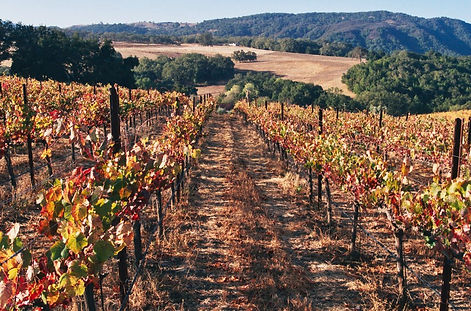Philippe Armenier leading a two-day biodynamic workshop at Hedges Winery on Red Mountain in Washington State
EXAMPLES OF VINEYARDS
FARMED BIODYNAMICALLY

Epoch - Paderewski Vineyards - May 2016
Paso Robles, CA

Epoch - Paderewski Vineyards - June 2016
Paso Robles, CA

Justin Vineyards - May 2016
Paso Robles, CA
Dry farmed Cabernet Sauvignon

Justin Vineyards - August 2016
Paso Robles, CA
Dry farmed old merlot vines

Realm Vineyards - May 2016
Napa Valley, CA
Cabernet Sauvignon
Notice how the leaves are turned upwards, cup up.

Realm Vineyards - June 2016
Napa Valley, CA

Realm Vineyards - July 2016
Napa Valley, CA

Demetria Vineyads - July 2016
Dry farmed vineyards in Los Olivos, CA

Sumida Vineyards - July 2016
Santa Lucia Highland AVA
Pinot noir

Pine Hawk Vineyards - June 2016
Paso Robles, CA
A typical californian sprawl

Villa Creek Vineyards - July 2016
Dry farmed vineyards in Paso Robles, CA
LOOKING AT THE CANOPY


Two Cabernet Sauvignon Vineyards in the Napa Valley.
This first photo shows a shoot in a vineyard farmed biodynamically for a few years.
The second photo shows a shoot in a conventionally farmed vineyard 30 feet away.
They are both planted in the same soil and are the same age.
- On the Biodynamic block, you can notice the typical gesture of a biodynamically farmed plant: the leaves are turned upward, the leaf petioles are curved up. The shoot is vertical, drawn up towards the Sun.
- In the conventionally farmed block, you can notice how the leaves are pointing down: the vines are too strongly attracted to the Earth, tending to seek the forces of gravity.
These two photos are a perfect example of some of the results we get from farming biodynamically, plants that are:
- Vertical. The forces of levity are strengthened.
- Turned more strongly towards the Sun; the Sun is no longer something outside the plant, but becomes a part of it, woven in the plant. The plant is living within the Sun.
Look at the two approaches of verticality found in a skyscraper or in a cathedral: the first is a 'false' verticality built up by a succession of horizontal planes, while the second is raised up around an inner, hollow verticality. We want to cultivate plants to become cathedrals.
To understand the particular gesture of the vine, please refer to the article by Erdmut Hoerner, Le Ble et La Vigne.

A four-year old vineyard before its conversion to Biodynamic Agriculture.
It grows in very dry conditions and expresses "no desire" to grow.

The same vineyard after two years of Biodynamic farming.
We are still in the same dry conditions of farming but we now see a very different movement in the canopy: we have changed the movement to one of uprightness.
Moreover, this photo was taken in 2014 during a period of intense drought. It had not rained in the past three years.

Here we are in Fall 2013 before conversion to Biodynamic farming.
The vineyard is 14 years old. The canopy is short and the vines did not grow much.

The same vineyard, though obviously not in the same season, a year and a half into its conversion, in Spring 2015.
The canopy is three times as full.
LOOKING AT THE SOIL


Spring 2010 - El Paso de Robles, CA
A soil before it's conversion to biodynamic farming.
One can observe that only one family of grass grows in the vineyard
Beside a mono culture of grass, the soil here has a poor structure, it could be easily eroded by wind or heavy rain . There is no microbial activity therefore no humus, therefore no structure. The grasses have a small root system and no desire to explore the deep layers of the soil.


Spring 2014
Above the same soil than pictured before but after 4 years of Biodynamic farming. One can see the well aggregated structure of soil. The soil is darker a sign of intense microbial activity and formation of humus. There is more diversity with the grasses and a particular important element is happening : it is the length of the grass’ roots. You can easily imagine that if the grass’ roots go stronger and deeper into the soil, vines’ roots will have the same movement.

The soil on the left side is coming from a pasture where cows are grazing, it has never been farmed, it is a “virgin” soil.
On the right side the same soil from the vineyard biodynamically farmed for 2 years situated 30 feet away from the left one.
The soil on the left has no structure, the grasses have a very poor root system. It is compacted and fractures horizontally.
On the right side you can see the soil starting to have a structure and one can notice the increase of roots’ length.




A vineyard from before its conversion to BD farming to four years later
October 2015.
Organic vineyard before its conversion to Biodynamic farming.
October 2016.
Same vineyard after 1 year of Biodynamic farming.
October 2017.
Same vineyard after 2 years of Biodynamic farming.
October 2019.
Same vineyard after 4 years of Biodynamic farming.